How to Develop a Cybersecurity Strategy for 2024: 7 Key Steps for Effective Protection
Explore the 7 key steps to craft a robust cybersecurity strategy for 2024. Learn to assess risks, implement technologies, and train your team for top defense.

Introducing 5G technology promise a major shift in the wireless industry. Users and service providers alike are excited about the potential gains from improved network connectivity. Meanwhile, implementing modern technologies is always full of challenges. More and more people will have access to the 5G network, which means a rise in cyber-attacks directly.
Adopting 5G technology can jeopardize a company’s cybersecurity in several ways, especially with the widespread use of Internet of Things (IoT) devices, which often have poor cybersecurity and no encryption.
This article demonstrates in detail the impact 5G technology has on cybersecurity.
The architecture of the 5G network poses the greatest threat. With the shift from today’s centralized hardware to the dynamic software of the 5G network, cybercriminals will have access to more potential entry points.
The existing networks had physical checkpoints to which all incoming and outgoing data had to be routed. Contrarily, 5G technology decentralizes the traffic across a network of digital routers with fewer checkpoints, reducing the efficacy of the existing cybersecurity measures.
In addition, 5G is entirely software-based technology, so updates, like OS upgrades, will be implemented in software, opening the cyber defenses to greater risk. Such threats are beyond the capabilities of the current cybersecurity infrastructure, which means it must be updated and improved, requiring more resources and knowledgeable personnel.
By 2023, Cisco estimates there will be 15.4 million DDoS attacks worldwide. The network architecture of 5G make it easier for cybercryminals using the distributed denial-of-service (5G) attacks.
Protection of such massive devices is challenging for cybersecurity teams, and the widespread adoption of 5G networks will devastate DDoS attacks.
IoT (Internet of Things) technology has been rapidly adopted by manufacturers and consumers alike. As device manufacturers prioritize ease of use and connectivity over security, these devices are being produced with almost no cybersecurity measures. The increased speed and concurrency made possible by 5G technology will encourage the widespread adoption of IoT devices.
As a result, more information will be sent, received, and compromised due to device flaws that have yet to be discovered. In addition, cybercriminals can use 5G’s improved connectivity to launch network attacks with unprecedented swiftness.
The main benefit of 5G technology is “Network Slicing,” which enables the development of secure, isolated wireless networks. By combining virtualized and independent logical network segments on a physical network, businesses can isolate the network segments used by their various client verticals. But this can lead to cyber threats like:
Hardware partitions in today’s 4G networks eliminate the “single point of failure” that would otherwise result from a cyber-attack, allowing cybersecurity experts to focus on protecting the rest of the network from further damage.
However, 5G networks use small-cell physical antennas with a shorter range and lower cost to cover the same area. It is growing difficult to protect these compartments, even though they share the same physical infrastructure. A dynamically deployed cybersecurity solution is likely to be necessary.
Network slices are possible with the help of the Control and User Plane Separation (CUPS) model, which results in an equitable distribution of network resources. Due to the nature of 5G’s deployment, many nodes are in insecure network edges, putting the CUPS at significant risk of having their data sessions intercepted.
Because network slicing makes it possible for a company’s disparate infrastructures to coexist on a single 5G network, a successful cyberattack against any component of a company has the potential to affect the whole. It is possible for a cyberattack to completely disable a network, a situation known as “availability compromise.”
Despite the benefits of end-to-end encryption in 5G networks, cybercriminals can still access the company’s data if they do not encrypt their connection from the beginning. Cybercriminals can learn what devices are connected to the network and target these devices soon after connecting to the network. They can also be more strategic with their attacks if they have information about the target’s operating system and device type (smartphone, vehicle modem, etc.).
Due to its exceptional efficiency, originality, and adaptability, 5G technology will continue to expand in the years to come. Though beneficial, this approach could also bring new cyber threats and complications. Companies should therefore consider stronger cybersecurity measures before moving to 5G network usage.